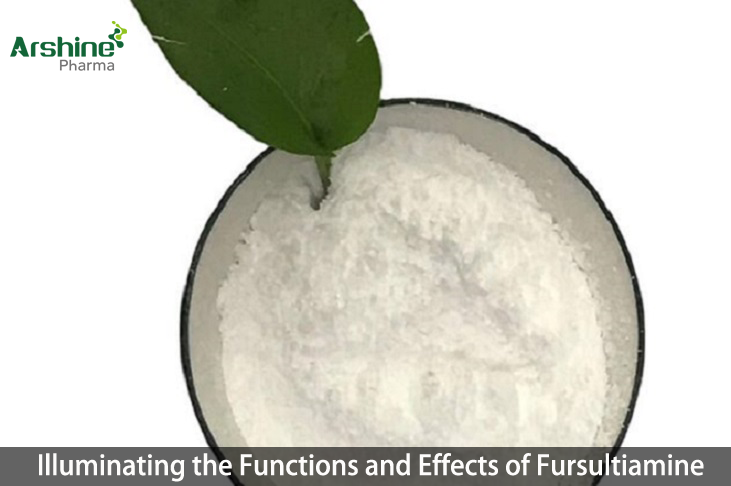
Fursultiamine, a derivative of thiamine (vitamin B1), holds a unique place in the realm of nutritional supplements. Recognized for its potential in addressing thiamine deficiency and associated conditions, fursultiamine has gained attention for its enhanced bioavailability and therapeutic efficacy compared to conventional thiamine supplements. Delving into the multifaceted functions and effects of fursultiamine involves exploring its role in thiamine metabolism, its applications in clinical settings, and considerations for its use as a nutritional intervention.
Introduction to Fursultiamine
Fursultiamine, also known as thiamine tetrahydrofurfuryl disulfide (TTFD), is a lipophilic derivative of thiamine, a crucial B-vitamin involved in energy metabolism. While thiamine deficiency is rare in developed countries, certain medical conditions, dietary habits, or genetic factors can lead to suboptimal thiamine levels. Fursultiamine, with its unique chemical structure and improved absorption characteristics, has been explored as a therapeutic option to address thiamine deficiency and its associated complications.
Chemical Structure and Enhanced Bioavailability
The chemical structure of fursultiamine includes a disulfide bond and a furfuryl side chain. These structural modifications enhance its lipophilicity and make it more soluble in fat, contributing to improved absorption in the gastrointestinal tract compared to conventional thiamine salts. This increased bioavailability is a key factor in the potential therapeutic benefits of fursultiamine.
Thiamine Metabolism and Functions
1. Coenzyme in Energy Metabolism
Thiamine plays a crucial role as a coenzyme in various metabolic pathways, particularly in the metabolism of carbohydrates. Thiamine is a vital component of thiamine pyrophosphate (TPP), a coenzyme involved in the decarboxylation of alpha-keto acids, such as pyruvate and alpha-ketoglutarate. This process is a key step in the production of adenosine triphosphate (ATP), the primary energy currency of cells.
2. Nervous System Function
Thiamine is essential for the proper functioning of the nervous system. It participates in the synthesis of neurotransmitters and is crucial for the maintenance of myelin, the protective covering of nerve fibers. Thiamine deficiency can lead to neurological complications, including peripheral neuropathy, Wernicke-Korsakoff syndrome, and beriberi.
3. Antioxidant Properties
Thiamine also exhibits antioxidant properties, contributing to the protection of cells from oxidative stress. As an antioxidant, thiamine helps neutralize free radicals, unstable molecules that can cause cellular damage. This protective role is particularly relevant in conditions associated with increased oxidative stress.
Therapeutic Applications
1. Thiamine Deficiency
The primary therapeutic application of fursultiamine lies in addressing thiamine deficiency. Thiamine deficiency can occur due to various factors, including inadequate dietary intake, malabsorption syndromes, alcoholism, and certain medical conditions. Fursultiamine, with its enhanced bioavailability, is considered a potential option to restore thiamine levels in individuals at risk of deficiency.
2. Neurological Disorders
Given the importance of thiamine in nervous system function, fursultiamine has been explored in the management of certain neurological disorders. Wernicke-Korsakoff syndrome, characterized by severe thiamine deficiency, is one such condition where fursultiamine supplementation may be considered to address the neurological complications associated with this disorder.
3. Mitochondrial Dysfunction
Thiamine is crucial for mitochondrial function, and fursultiamine's enhanced bioavailability may have implications in addressing conditions related to mitochondrial dysfunction. Mitochondrial disorders, characterized by impaired energy production, could potentially benefit from interventions that optimize thiamine levels, although further research is needed in this area.
Effects and Considerations in Clinical Use
1. Enhanced Bioavailability
The enhanced bioavailability of fursultiamine is a significant factor in its therapeutic potential. Studies have suggested that fursultiamine is more efficiently absorbed compared to conventional thiamine salts, leading to higher thiamine levels in the bloodstream. This characteristic makes fursultiamine an attractive option in situations where optimal thiamine absorption is essential.
2. Safety Profile
Fursultiamine has demonstrated a favorable safety profile in clinical studies. Adverse effects are generally mild and transient, with gastrointestinal symptoms such as nausea being the most commonly reported. The safety of fursultiamine supplementation should be considered in the context of individual patient characteristics and underlying medical conditions.
3. Individual Response
As with any nutritional intervention, individual responses to fursultiamine may vary. Factors such as the underlying cause of thiamine deficiency, the severity of the deficiency, and individual variations in metabolism can influence the response to fursultiamine supplementation. Close monitoring and personalized approaches to dosing may be warranted in certain cases.
4. Regulatory Status
Fursultiamine is regulated differently in various countries. While it has been approved for use in some regions, in others, it may be considered a dietary supplement rather than a pharmaceutical agent. The regulatory status influences the availability and prescription of fursultiamine in clinical practice.
Conclusion
Fursultiamine, with its unique structure and enhanced bioavailability, offers a promising avenue in the management of thiamine deficiency and associated conditions. Its potential applications in addressing neurological disorders and mitochondrial dysfunction underscore the importance of thiamine in various physiological processes.
As research continues to unravel the nuanced functions and effects of fursultiamine, its role in clinical practice may evolve. The consideration of individual patient characteristics, the underlying cause of thiamine deficiency, and the safety profile of fursultiamine are essential aspects of its clinical use. Fursultiamine stands at the intersection of nutritional science and therapeutics, providing a targeted approach to addressing thiamine deficiency and optimizing health outcomes.
